




changes could impact the sector and foundation requirements, the number of credits in each major, and the College’s mission statement.
The Daily Pennsylvanian spoke with administrators, professors, and students about what these changes may look like and how they reflect the value of a liberal arts education at Penn.
I don’t think that there has been a whole scale look at the majors in the way that we’re talking about doing it now.
“The purpose of the major is clear: it provides an intellectual ‘home base,’ and a perspective from which to understand, criticize, engage with and improve the world,” the 2005 announcement from former College Dean Dennis DeTurck reads. “But in order to do so constructively, our students must also appreciate the importance and relevance of fields in which they have not developed particular expertise.”
The College is now in the process of reviewing the curriculum on a large scale for the first time since this announcement — though the timeline for implementing any changes remains unclear, and the school continues to consistently review its academic framework. Potential
The decline of the liberal arts Liberal arts programs have seen a decrease in student enrollment and funding at large public schools and small liberal arts colleges alike. This phenomenon is happening at Penn.
Since 2003, the University has seen a decline in the number of students graduating with degrees in the humanities and the social sciences as well as a simultaneous rise in the number of students graduating with degrees in natural sciences.
“One thing that we are all super aware of is that the humanities majors are just tanking,”

College junior Ria Ellendula and Wharton sophomore Michelle Chen will serve as the Undergraduate Assembly’s next president and vice president. The Nominations and Elections Committee announced the results on Wednesday, April 10 at 8:56 p.m. after voting closed on Tuesday, April 9 at 11:59 p.m. Ellendula was elected president by a vote of 830 to 694 over College junior Hannah Liu, and Chen was elected vice president by a vote of 876 to 603 over College junior Mackenzie Sleeman. This spring’s election also decided leaders for the 2025, 2026, and 2027 Class Boards. The total amount of votes cast in the presidential election was 1,524, an increase from last year’s total of 1,280.
Nominations and Elections Committee Chair Yousef Elyoussef told The Daily Pennsylvanian that the voter turnout was the highest since before the COVID-19 pandemic. He said that approximately 24% of Penn’s campus voted or opened the ballot, a 5% increase from last year’s tally of 19% — a fact which he described as “awesome.” Ellendula, the president-elect, and Chen, the vice-president-elect, ran on a platform — ”An Intentional Penn” — structured around diversity and equity, academic initiatives, inclusion, and student wellness.
During the campaign, Ellendula spoke about her love of advocacy. She added that her platform aims to bring “high impact solutions” to students. In an interview with the DP, she expressed excitement in being elected as president, citing her positive experience in the UA so far.
“I feel like being involved in student government has been such a fulfilling experience and has been the channel through which I can pursue my love for advocacy,” Ellendula said. “I’m really honored and blessed to have been elected as president, and hope that I can do as much justice to the position as I can in the upcoming year.”
Ellendula also expressed hope that her initiatives as president would help build community and improve students’ experiences.
“I hope that we can




Street.
The DP compared the costs of basic groceries at ve grocery stores that lie within one mile of Penn’s campus
From ACME Markets to Trader Joe's, the hunt for affordable groceries as a college student can be challenging — so The Daily Pennsylvanian analyzed differences in pricing across grocery stores in and around campus.
The DP compared the costs of basic groceries at five grocery stores that lie within one mile of Penn's campus: ACME Markets, GIANT Heirloom Market, Trader Joe’s, Aldi, and Supremo Food Market. Prices were logged at each store for a set of staple food options in five different categories, and they reflect the store-brand products, or the lowest-cost product if there was not a store-brand option.
The analysis found that GIANT Heirloom Market had the most expensive total cost for groceries.
While the University offers meal plans for all
CURRICULUM, from FRONT PAGE
leadership crisis — donors to the University questioned the value and quality of the College, where all undergraduate liberal arts majors are housed.
These critics include Wharton Board of Trustees Chair Marc Rowan. In a Feb. 27 interview, Rowan said that faculty members in the School of Engineering and Applied Science, the Perelman School of Medicine, and the Wharton School are committed to “academic excellence and research,” while faculty in the College are “not so much.”
A spokesperson for Rowan did not respond to a request for comment.
Sniegowski described “external pressure” relevant to discussions about curriculum changes, but clarified that this influence is not the primary motivation for potential changes.
“Our motivation is not defensive,” Sneigoswki said. “Our motivation is creative and supportive of our students and our mission.”
Peter Struck, a professor of classical studies and chair of the College Curriculum Committee, pointed to the need for further emphasis on the value of the liberal arts.
“We’ve got strong messages here about the importance of pre-professional education and that’s great,” Struck said. “I also think we need strong messages about the importance of a liberal arts education.”
Potential curriculum changes
four years, Penn requires students to enroll in on-campus meal plans for their first two years at the University. However, due to a variety of factors — including dietary restrictions, a desire for more variety, and dissatisfaction with on-campus options — students often opt to find meals elsewhere. Many students choose to make meals on their own, requiring regular grocery shopping.
Jocelyn Gao, a first-year graduate student in the School of Engineering and Applied Science, said that she cooks for herself “pretty often,” as there is no graduate student meal plan, and she prefers to do her own cooking.
Gao added that she generally chooses to buy her groceries at certain locations based on convenience or due to a desire for variety. However, she said that knowing more about prices at
their early stages, but administrators and faculty are examining several specific areas. The review is being undertaken by committees such as the Committee on Undergraduate Education and the Curriculum Committee.
McGlone said that while there is still consensus on wanting to expose students to a broad range of disciplines — such as the physical world or arts and letters — there is also a “general sense of agreement that it’s not clear to students what those things mean.”
She added that committees within the College, such as the Committee on Undergraduate Education, hope to “take stock” of the existing system and “reinvigorate the conversation” surrounding what each of the requirements actually means.
As part of the general education requirement, students in the College must take classes across seven ‘Sectors of Knowledge’ and six ‘Foundational Approaches’ in addition to completing their major coursework.
But the general education requirements are “overcomplicated” and “really confusing,” College junior Eric Yao told the DP. College senior and Co-Chair of the Dean’s Advisory Board Rushil Vellala added that his experience with general education courses has been “mixed.”
“On one hand, I enjoy the degree of exploration I can undertake,” Vellala said, “However, there are times where some of the sectors are not conducive for my own learning … and I feel like I am taking courses just for the sake of it.”
Josephine Park, a professor of English and chair of CUE, wrote to the DP that the committee has held conversations about specific elements of the general education curriculum, which led them to “many more questions about the broader
Conversations about curriculum changes are in that continue to invest in advancement during downturns of various types have a faster return,” she wrote in an email to the DP.
The Penn Fund is the University’s annual giving program, for which undergraduate students are the sole beneficiaries. The fundraising program supports grant-based financial aid packages, academic programs, and student clubs and organizations.
This year’s fundraising goal is $46 million, and a total of $24.9 million in donations were displayed on the Penn Fund “progress” webpage as of April 3. 11,167 individual donors contributed to this total.
At this time in 2023, the same web page showed $31.5 million in total donations from 14,976 individuals. The fundraising goal of $46 million was the same.
According to Larissa Reece, who studies fundraising in higher education as a Senior Consultant with nonprofit consulting firm Ashley Rountree and Associates, the size of the decrease “is an indication that a crisis is affecting the fundraising.”
In November, the DP spoke with Reece about how ongoing controversies related to antisemitism and free speech culminated in backlash from prominent donors. She predicted then that well-publicized donor splits with Penn were the “tip of the iceberg.” She further predicted that a decrease in smaller donations to the annual fund could “leave a dent” in Penn’s finances. Cara Giacomini — vice president of data, research and technology at the Center for Advancement and Support of Education — pointed to the importance of investing in advancement activities “after a setback.”
“In our studies we have seen that those institutions
According to Reece, Penn should focus on “oneon-one” conversations with “as many donors as they possibly can.”
She further explained that it is critical for students’ perspectives to reach donors because“it's not so much about the institutions, it is what it's doing for students.”
The Red and Blue Engagement Center, which organizes fundraising phone calls — including from students — did not respond to a request for comment.
Giacomini also discussed the importance of “strong communications," "showing the impact of support,” and “engagement activities.”
On Tuesday, the Penn Fund hosted a “Donor Appreciation Celebration” on Locust Walk. At the event, students were encouraged to write “thank you” notes to alumni donors who support “current and future Quakers.”
According to Reece, “many donors will just wait to see what's going to happen" under an interim president. She said that once a permanent president is named, donations may increase.
Giacomini explained that fluctuations in annual fund giving amounts don’t usually have a “significant impact” on student programming in the short term.
These fundraising discrepancies come in the wake of donor retaliation in response to Penn's handling of the Palestine Writes Literature Festival and the Israel-Hamas War. Throughout the fall 2023 semester, dozens of donors — including Wharton Board of Trustees Chair Marc Rowan — called for alumni and supporters to "close their checkbooks" until former President Liz Magill and former Board of Trustees Chair Scott Bok stepped down.
different locations would “have some impact on [her] choices.”
The most expensive grocery store within the given set of items is GIANT Heirloom, followed by ACME — the two grocery stores closest to Penn’s campus. Aldi had the lowest costs, followed by Trader Joe’s. Total costs at Aldi are approximately 26% lower than at GIANT Heirloom. Aldi and Trader Joe’s are also the two stores farthest from campus. Professor of Epidemiology and Nursing Karen Glanz pointed to the challenges that undergraduate students face while grocery shopping.
“In general, the undergraduate student population will mostly not have cars, and will have their environment somewhat limited to where they can walk,” Glanz said. “Uber and bus and
structure.”
Struck added that there is an “interest among faculty” in rethinking the requirements.
The Curriculum Committee and CUE are both considering the value of first-year seminars — small classes limited to first-year students that also fulfill general education requirements. Sniegowski emphasized that he would like to see more students enroll in them.
Park said that while most discussions have focused on “brainstorming,” there have been “focused discussions about the first-year seminar as a way of establishing a home base for entering students.”
Yao said that while he “really liked” his firstyear seminar, he does not think the College should require them, explaining “it should be something that’s just there for people that want it.”
Another conversation in these committees has surrounded the disparity in the number of credits required for each major in the College. Next year, McGlone is hoping to create a subcommittee that will examine this topic, with a goal to “simplify” the major and degree structure.
The number of required credits for majors within the College varies significantly. According to the College website, majors can require between 12 to 20 courses. This variation also impacts the number of courses that are required for a student to graduate, with 32 to 36 credits required depending on the number of in-major courses required.
“I don’t think that there has been a whole scale look in the majors in the way that we’re talking about doing it now, so it’s a little daunting, but I think necessary at this stage,” she added.
things like that can help, but shopping is usually a little more challenging.”
Despite these overall trends, a grocery store’s average pricing is not necessarily always indicative of an individual item’s cost. Though total prices at Aldi are lower than at any other location examined, meat at Aldi is more expensive than at ACME, the second-most expensive store measured.
Additionally, while Trader Joe’s and Supremo are similar in price points, grains are 37% cheaper at Trader Joe’s, while meat and produce are 20% and 36% cheaper at Supremo, respectively.
College junior Hannah Liu said that the differences in cost “make a lot of sense” as a student who has been regularly utilizing the stores for three years.
“What I would spend on a week of groceries [at Trader Joe’s] would be significantly less than what I would spend at Acme for like two days,” Liu said. “I just always pay attention to fluctuating prices.”
Liu added that she tends to prefer grocery delivery services like HelloFresh for convenience. She said that it can be hard to fit in time for groceries, and she finds the options to be at a lower price “than if you were to go out and overspend … since it’s getting you exactly what you need.”
Other grocery options include International Foods & Spices, Makkah Market, and Alrayyan Food Market — a cluster of ethnic grocery stores on Walnut Street catering to South Asian, Islamic, and Middle Eastern populations respectively.
These grocery stores were not included in the DP’s analysis because they did not carry some of the staple items analyzed. However, they offer an array of specialty and cultural food items that may not be readily available at more popular options. In some instances, cases of produce or prepackaged items can be cheaper than alternatives. For example, a pound of tomatoes at International Foods and Spices costs $1.99, a full dollar cheaper than at ACME, GIANT Heirloom, and Trader Joe’s.
Both Glanz and Liu said that they value healthier foods, but noted that there is usually a tradeoff in price. Glanz said offering healthy, high-quality foods is not the "top priority" of many stores.
“Quality of food is a really privileged thing to talk about, and if you are able to go the distance and get those groceries at a high-quality place at a higher price, definitely utilize that,” Liu said. “But also recognizing that some of us can’t do that all the time … I think that’s also really important to think about.”
Senior reporter Jin Kwon and staff reporters
Anmol Dash and Sina Shaikh contributed to the data collection for this article.
How course units and sector fulfillments vary by major and concentration Administrators are also in the process of examining the written mission statement of the College, which has not been updated in over a decade and is currently over six paragraphs long.
University Life Executive Director of Strategic Initiatives Mike Elias told the DP that he and McGlone began rewriting the mission statement in late March to “think about how we not only refresh the language, but actually make it relevant to the 21st century.”
Sniegowski hopes that the revised mission statement can be both “strengthened” and “shorter” while also make “an abundantly supportive case for the value of the liberal arts, and what the liberal arts are.”
The perspectives of faculty and students are at the center of these discussions around curriculum changes.
“The faculty own the curriculum,” McGlone said. “We have faculty that decide what we teach, how we teach it, and the policies that go around it.”
Students are also involved in the work of the committees and have “an equal voice in the discussions,” according to Sniegowski.
“An amazing group of faculty give a lot of their time to talking amongst themselves and with student representatives about how we educate students in the liberal arts and how they might do that better,” Sniegowski added.
While Sniegowski announced he is leaving Penn on Aug. 1 to become president of Earlham College, the College remains “fully committed to the ongoing review of the General Education requirement,” the College Office wrote in a statement to the DP.
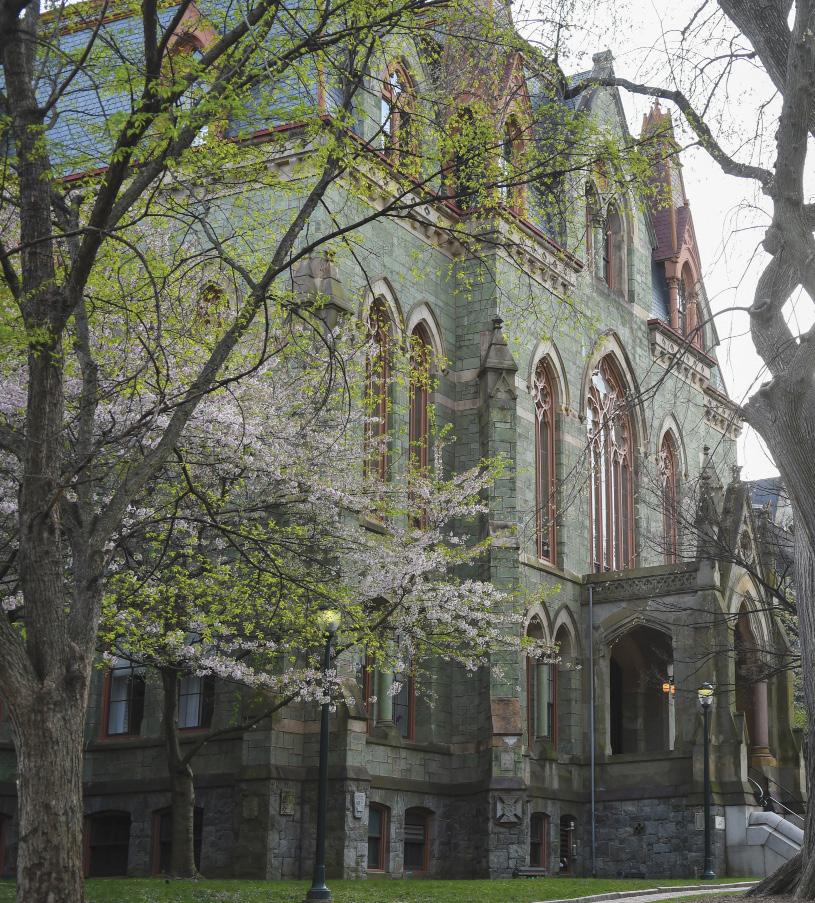
members of our community rages on. This is unacceptable.
I have devoted countless hours to meeting with the administration to address antisemitism, and those concerns have been met with meaningless words and empty promises.
I was invited to speak to the House Committee on Education and the Workforce to share my experiences of antisemitism at Penn. Here is what I told them:
On Sept. 19, I met with the Office of Public Safety to plead with them to do more to protect Jewish students. I was told that Hillel was one of the safest buildings at Penn. Two days later, Hillel was broken into and vandalized by a perpetrator who was yelling “F**k the Jews!” and “they [Jews] killed JC!” Two months later while I was eating lunch, bomb-sniffing dogs came through the building after staff received hate mail. Some Jews avoid Hillel altogether now. This is unacceptable.
Countless antisemitic incidents happened in the immediate months following Oct. 7, culminating in a riot on Dec. 3.
A mob of students, faculty, and additional extremists marched through our campus recording themselves — with reports afterward documenting vandalized school buildings, smoke bombs, and vicious chants screamed in English and Arabic. “There is only one solution, Intifada revolution!” — This combines Nazi messaging (one solution) with the promotion of coordinated terrorist attacks on Israeli and Jewish civilians from 1987 to early 1990s and 2000 to 2005 (Intifada).
“The gate of Al-Aqsa is made of iron; only the martyr in spirit and blood can open it. We sacrifice for you, O Al-Aqsa!”
(Translated) — This glorifies violence, martyrdom, and selfsacrifice against Jews to ‘protect’ the Jerusalem Al-Aqsa mosque; Hamas named the Oct. 7 attacks “Operation Al-Aqsa Flood” under this same false pretense.
“From water [river] to water [sea], Palestine will be Arab!”
(Translated) — Calling for the elimination of the state of Israel and Arabization of the land is a call to genocide against over seven million Jews in Israel. Penn Against the Occupation has used this specific, extremist chant on other occasions.
The next morning, we were confronted with the hate again as we walked to class: The bank across from Huntsman Hall was graffitied with the words “Blood $.” Combining the medieval antisemitic tropes that Jews have a lust for blood, are greedy, and control the banks. “Avenge Gaza” was sprayed next to Pottruck Health and Fitness Center — calling for violence in our own community. 3401 Walnut was defaced with “Intifada.”
Despite these and countless other antisemitic incidents, our Jewish institutions still do not get basic and reliable University

support with security. In my experience, police presence at Hillel is wishy-washy at best, and the University has yet to offer ongoing support to Chabad or MEOR. This is unacceptable.
I also told Congress about the moral bankruptcy within our faculty:
Professor Ahmad Almallah skipped teaching his own classes to harass and intimidate Jewish students by leading Intifada chants. This is unacceptable.
Professor Robert Vitalis posted a Hamas military brigade patch on his Facebook in October with the caption: “A quick and easy way to reduce my friends list (and it will look cool on your jacket too).” This is unacceptable.
Professor Dwayne Booth has created horrifying blood libel cartoons, and the website where he shares them is still promoted on his official Penn bio. He was just renewed for next semester. This continues and is unacceptable.
Professor Huda Fakhreddine posted on Oct. 7 in Arabic that “While we were asleep, Palestine invented a new way of life,” and clapped at a protest after the speaker told Jewish students to ‘‘...go back to Moscow and Brooklyn and Gstaad, and f**king Berlin where you came from…” This is unacceptable.
Professor Tukufu Zuberi retweeted on Oct. 7, “by what standard of morality can the violence used by a slave to break his chains be considered the same as the violence of the slave master.” This is unacceptable.
Professor Anne Norton posted on Oct. 7 that “Palestinians have the right to defend themselves,” and later liked a tweet that “playing the victim is what Jews are best at.” This is unacceptable. The list goes on and on. This is unacceptable.
The University has done nothing to address any of these horrific acts or even reach out to students affected within their classes. Why is Penn so helpless while others act? Penn has recently brought disciplinary actions against faculty and

the more than 30,000 Palestinians killed by the Israeli military in the past five and a half months alone; perhaps, if Hillel called attention to the 20,000 children Israel’s assault has newly orphaned; perhaps, if Hillel decried the forced displacement of over one million Palestinians from their homes into the Rafah Governorate, an area typically home to a population only one third as large; perhaps then, we might believe that Israel Week celebrates dialogue or heritage. But Hillel pretends that Palestinians do not exist.
For Hillel, Israel Week is every week of the year.
students under other circumstances.
We’ve been told, over and over again, that “the University is taking these issues seriously.” That there are task forces convening and “confidential” proceedings taking place. Why has nothing changed then? The task forces have led to no changes on campus and the Jew-hating members of our community continue to act with impunity.
We heard loud and clear at the now infamous hearing with Magill that context matters. Here’s the context: it’s open season for Jews on our campus, and continued inaction by our University is unacceptable.
On Feb. 26, the latest protest that stormed through campus started with calls for an Intifada and finished with Jordan Vaughan, an avid Hamas supporter screaming, “We won’t stop at a cease fire!” Jordan later posted the names and phone numbers of Jewish students who commented on the protest in a private Jewish group chat. Later that week, Jordan posted “POWER TO ALL OUR MARTYRS LONG LIVE THE RESISTANCE” with photos of 13 terrorist groups including Hamas, the Popular Front for the Liberation of Palestine (PFLP), and the Al-Aqsa Martyrs Brigade.
Despite all of this, Jordan was invited to and participated as a panelist in a Zoom last week hosted by the Max Kade Center.
It’s time to wake up Penn. Seriously, what are we waiting for? DO SOMETHING!
for simply screening a film, or now, when our peers face discipline for simply using the library while their posters displaying the faces of murdered Palestinian journalists remained visible on library tables. Nor does Hillel host these events out of a deepseated belief in the value of heritage. If Hillel valued heritage for all people, they would defend the rights of our peers and professors to study Palestinian history.
Perhaps, if Hillel demanded an immediate ceasefire and an end to Israeli apartheid; perhaps, if Hillel so much as mourned
It is a profoundly challenging and upsetting time to simultaneously be Jewish and have to denounce Hillel. Now is the worst possible moment for division in the American Jewish community. We face the potential return of a president of the United States who defends flag-waving neo-Nazis — whether they organize themselves, as in Charlottesville, or whether he rallies them to overthrow the United States government, as on Jan. 6, 2021.
Faced with such a threat, the Jewish community should stand united. We should stand in deep solidarity with as many of our fellow citizens as possible. Our history teaches us that authoritarianism must be stopped before it rises. You can’t put the genie back in the bottle.
But Hillel seems blinded by its commitment to Israel. Recall the remarks of Rep. Elise Stefanik (R-NY), who questioned former Penn President Liz Magill in Congress this fall. Recall
Stefanik’s endorsement of congressional candidate Carl Paladino, who called Hitler “the kind of leader we need today.” Recall Stefanik’s endorsement of Donald Trump, who has repeatedly praised neo-Nazi insurrectionists. Then, recall Stefanik’s fateful question to Magill about the relationship between Penn’s free speech policy and hypothetical “calls for Jewish genocide” on campus.
Stefanik did not ask this question out of concern for Jewish safety. Her question was a cynical ploy to cripple free speech and degrade calls for Jewish safety into weapons for her own political gain. But instead of calling out Stefanik for her blatant antisemitism, Hillel parroted her comments. Why? Because Stefanik sought to suppress criticism of Israel.
We need Hillel to change course. As progressive Jews, we need Hillel to stand up for us the way Hillel expects us to stand with them. That means standing up for the humanity of our Palestinian peers, not pretending that our peers do not exist or celebrating the state that acts to wipe them out. And it means standing up to a few donors, even if it costs you your job. Palestinians in Gaza are losing far more.
As long as Hillel’s idea of Jewish unity demands acquiescence to Israeli war crimes, Hillel divides Penn’s Jewish community. Israel Week forces us to choose between Hillel’s version of Jewish unity and our Jewish values. We do not want this choice. We should not have to choose. But if Hillel forces us, we choose our values: (Lo Ta’amod ‘al Dam Re’echa); “neither shalt thou stand idly by the blood of thy neighbor” (Leviticus 19:16). Palestinian lives are as precious as ours.
We ask of Penn Hillel what we have always asked. Open Hillel. Call for an immediate ceasefire and an end to apartheid. Let’s raise the call together. We are ready when you are.
PENN CHAVURAH is a leftist Jewish student group founded in 2021 as a response to the strong Zionist ties of Penn Hillel, which isolates parts of Penn’s Jewish community. Chavurah serves as a place of Jewish community and cultural celebration on campus, with biweekly Shabbat dinners and other discussion and speaker events. Chavurah welcomes all students to attend our events and get involved. Their email is pennchavurah@gmail.com.
PENN CHAVURAH BOARD
Jack Starobin, Izzy Feinfeld, and Lily Brenner

THE AIYER ASSESSMENT | So you got into Penn — now what?

To the incoming Class of 2028, congratulations! You have entered the tricky lottery that is the college admissions process and come out on the other side victorious. You likely poured your heart into every minute detail of your application in the hopes that the admissions office would select you, above every other qualified candidate. I was in your exact position just two short years ago.
My application, like that of many admitted students, was a carefully curated collection of my passions, aspirations, and achievements. It showcased the very best version of myself, in every letter grade on my transcript and sentence of my Common Application essay.
To the admissions committee, I was an aspiring linguistics major with musical talent and a

dedication to community service. My international upbringing provided me with unique, worldly perspectives, and I expressed a special interest in exploring the city of Philadelphia through classes and extracurriculars. My teachers and counselor described me as a hardworking team player who was a joy to have in class.
Two years later, I can confidently say that the person in my application — the one with the electric personality, near-perfect grades and wildly lofty ambitions — is not who I am today. In fact, she’s also not the person that I truly was a year and a half ago when I clicked submit on my application. Behind those bold words and ideas lies somebody who is a lot less sure of herself. She has regular moments of clarity but also the crippling fear that she is
experiencing a midlife crisis at the age of 19.
I suspect that I am not alone in feeling that way. The competitiveness of college admissions requires us to craft a persona. Given Penn’s sub-6% acceptance rate, applicants have no choice but to present themselves in a perfectly palatable way. We make promises to the admissions committee, in regards to the person we are and the person we hope to become on their campus.
However, these promises were made to be broken. I recently reread my application to Penn, and seeing the disconnect between the messages I’d penned and the life I currently live was jarring. The future I visualized with paragraphs of flowery descriptions portrayed a version of my current self that has not come true in the way I intended.
This has been a difficult thing for me to come to terms with. What exactly does it mean when we drop our intended majors, or when we replace a future career in the arts for something a little more lucrative, like finance or consulting? Call it the Ivy League sellout culture, or maybe just call it selfdiscovery.
Indeed, opportunities for self exploration run rampant at Penn. With over 450 student organizations and countless ways to find community, it is not uncommon for us to morph into new, oftentimes better versions of ourselves during our four years here. Writing for The Daily Pennsylvanian, for instance, was never something that had crossed my mind before entering college. I had zero experience with journalism and had never even regarded myself as a good enough writer. Now, here I am.
But there may just be a larger issue at hand. Elite college admissions forces applicants to shapeshift.
CHAT WITH CHLOE | Surveillance culture and data exploitation detrimentally affects female celebrities
This is an official apology to the Princess of Wales. The complex relationship between celebrities and surveillance is well established. Losing your privacy comes with the job title, and while it may be worth the wealth and success that follows, oftentimes one has to admit that it becomes dehumanizing. Celebrity lives are seen as communal, almost, their secrets required to be a Google search away. As privileged as celebrities are, one privilege they definitely lack is that of privacy.
Kate Middleton’s disappearance from the spotlight during these last few weeks led to intense scrutiny of her life and whereabouts. After Kensington Palace announced that she underwent abdominal surgery in January, she had been keeping a low profile. Even though the royal family confirmed that Middleton was “unlikely” to resume her normal public duties until March 31, her exit from the public eye triggered a mass social media reaction, our feeds blowing up with theories of her absence, ranging from Prince William’s alleged affair to Middleton’s own planned death.
On March 10, the speculation reached a climax — Middleton’s Mother’s Day photo with her kids was proven to be heavily retouched. Immediately the Press Association, the most reliable newswire concerning the Royal Family, and many other international media outlets killed the photo from their service. The next day, she apologized to the public on X, formerly known as Twitter: “Like many amateur photographers, I do occasionally experiment with editing,” the statement began. Unfortunately, her excuse was not enough to dispel any rumors. Her privacy went from disrespected to completely invaded with the breach of her medical records at The London Clinic, as reported by The Daily Mirror. Just 11 days later, Middleton broke her silence, announcing on video that her absence was due to cancer. The extreme conspiracies that followed her break from the public succeeded in forcing her hand, pressuring her to broadcast her illness to the world.
The Middleton scandal sounds all too familiar — it mirrors the same surveillance of many other female
celebrities. In fact, their lives are dug apart in a way that male celebrities’ aren’t. A publicist with clients such as Ben Affleck and Barbra Streisand even explained that “women get rougher treatment” in the media “without a doubt.”
For example, when an old video of Heath Ledger surrounded by drugs at a party was dug up by Entertainment Tonight after his death by accidental overdose, the producers did not broadcast it to respect his family. However, The Sun did not hesitate to publish images of Amy Winehouse smoking cocaine and admitting to taking Valium. Likewise, the reaction to Kiefer Sutherland’s release from jail after a 48-day sentence for a driving under the influence case was mild in comparison to the harsh response to Paris Hilton’s 45-day sentence for a similar crime. Going back to the royal family, there is much more online criticism of Meghan Markle than Prince Harry.
In fact, harsh media treatment of female public figures exists — or, existed — right here on our campus: former Penn President Liz Magill. Last semester saw the end of her career at the University, encapsulated by mountains of critical articles by newspapers and magazines, nasty online comments, and of course, the infamous SNL sketch that mocked her testimony before Congress. The ruthless treatment of Magill by the media sped up the already fast decline of her image, having helped set a hostile public attitude against her.
Combating surveillance is a difficult task, yet some women are spearheading the movement to take back their image from the hands of sexist media. One great example is Monica Lewinsky, whose reputation was destroyed after her affair with former President Bill Clinton was exposed. This year, Lewinsky became the face of the “You’ve Got the Power” campaign by the fashion brand Reformation. She has finally made headlines on her own terms, redefining herself as a political figure in her own right as the ambassador of a campaign that encourages voting. Through this, Lewinsky is beginning to tear down the image of her as

Walking down Locust Walk every day is one of the most universal experiences at Penn. Everyone knows what it feels like to be running late — embarrassingly half-rushing to get to class on time — or lingering by the compass to meet friends, or standing with a blaring speaker during a passing period handing out flyers for your club. Locust Walk is the heart of Penn and where I feel most connected to the larger student body. However, that feeling starts to dissipate as I get farther and farther from Locust. When I arrived at Penn around six months ago, I was surprised by the lack of a homogenous school culture. Yes, I’ve found camaraderie and community within classes, clubs, and individual friendships, but I often feel like those things are separate from the fact that I attend Penn. Perhaps over time, these experiences begin to meld into one cohesive sense of belonging. Yet I often reflect on how, as a first-year, Penn culture seems
to revolve around the idea of being unique or differentiated from the pack, forcing students to seek out separate areas in which to build community. Penn Admissions says that each one of us is special for being handpicked to join our respective classes: in the Class of 2027 admissions blog, they praised the applicants for their prowess, achievements, and talent. However, I’ve found that this concept of implied specialness does not dissipate when we step onto campus. It’s common to see students noting that they attend Wharton rather than Penn in their Instagram bios, just so we know. If calculated, the admission rate to certain preprofessional clubs would certainly be lower than the most lauded universities. And oftentimes the Greek life culture perpetuates the idea of an invisible social hierarchy. During the first weeks of the year, I was disappointed by the hasty formation of cliques and
We vie frantically for the chance to secure a seat in the ivory tower, even if that means exaggerating our passions and very identities. Even worse, the application process forces us to reaffirm these identities over and over again, be it through the ideas expressed in our supplemental essays or the intended major drop-down. It is not surprising then that many students, myself included, find it difficult to disentangle themselves from their application personas.
Since coming to Penn, I have felt immensely guilty forgoing my linguistics aspirations, abandoning a prior musical talent, and finding new activities in which to invest my time. However, I think there’s something beautiful about how a new environment, opportunities, and people can change us. While clicking submit on my application two years ago, it was this hope that caused me to leave home to attend college oceans away.
I assure you that departing from your application self is not only normal and expected, but it is something to aspire to. When you think back to the person you were before coming to Penn, you may not recognize them. You may reread your application like I did and realize that your future has turned out differently than how you anticipated. And that’s okay. As you begin this four-year journey, be it at Penn or any other institution that you choose to attend, allow yourself the grace of growth.
SANGITHA AIYER is a College sophomore studying cognitive science from Singapore. Her email is saiyer@sas.upenn.edu.

just a “ditsy, predatory White House intern who might have lied under oath for a job at Revlon” as described by The New York Times in 1998. However, surveillance culture doesn’t just affect celebrities; in fact, it is present in our daily lives too. We all know that many social media platforms exploit our data for profit, yet the data sold has different consequences for women. It is estimated that 50 million women worldwide use period-tracking apps, which collect extremely personal information beyond your period dates, such as whether you have experienced a miscarriage or are trying to get pregnant. This medical data could affect things like how much you are paying for life insurance or even how you are treated in the workplace, without you knowing. As femtech, or women’s health technology, grows — with a predicted value of $50 billion by 2025 — women’s surveillance becomes more dangerous. Unlike medical records, health
apps are not covered by the Health Insurance Portability and Accountability Act, meaning companies have more freedom to choose what they want to do with your data, whether it’s sharing it to create personalized ads or tech firms.
Privacy is a right not just for celebrities but for all of us. However, data exploitation hurts women differently than men. We need to start practicing better media literacy as well as consider societal prejudices before slapping judgment on female stars, who suffer particularly hard under the burning gaze of the public eye.
CHLOE CHEN is a College first year from Vancouver, B.C.
an apparent overreliance on previous connections and friendships that had existed before Penn. The prevalence of exclusive, ticketed events enforced this social segregation. Even within days of arriving on campus, Penn students are faced with the decision, along with many others, to attend either a fraternity darty or the class photo on Franklin Field, creating a dynamic from the beginning that students must choose between Penn and other exclusive groups.
Now with the upcoming Spring Fling, students are choosing not to attend in favor of events unaffiliated with Penn. Not just because they don’t care for Metro Boomin’s music, but because for many, attending school-sponsored events is neither important nor meaningful, especially since this idea is reinforced as early as NSO.
Other aspects of Penn also appear to intentionally maintain a certain level of exclusivity that hinges on proving how special and one-of-a-kind you are. Club culture has spiraled out of control in that many of the preprofessional groups require rounds upon rounds of interviews, expecting their candidates to already be proficient in a field when they have only just stepped onto campus. The exclusivity of these clubs feeds into anxiety that you have to differentiate and market yourself as special to earn opportunities to learn and join extracurriculars.
Moreover, the competitive preprofessional culture and crazed evolution of the job recruiting process at Penn inevitably play a role in this pervasive need for students to feel different from one another in spheres beyond just professional. But Penn, as an institution, also supports the concept that it is academically and socially beneficial to place individuality over that of shared values and collaboration. This is evident through Penn’s reputation, on campus and beyond. Students take it for fact and frequently describe Penn as preprofessional, competitive, and emphasize the work hard, play hard culture, so even if Penn’s
administration does not concur with these descriptions, they are well-embedded within the general consensus of the student body. Not to say that this is all a bad thing. Penn students are awarded a rare opportunity to carve out their own world at Penn without any restrictions or obligations. However, the risk is that — after the first few months of forging friendships and joining groups — students emerge feeling more allegiance to their team, fraternity, club, or undergraduate school than to Penn itself.
It is inevitable that each student here will use a different formula to make the most of their college years and will be fulfilled by different things. However, at the end of the day, we are all receiving a diploma from the University of Pennsylvania — and not the tens of other communities that we chose to be a part of. I wonder when we are no longer walking down Locust every day — constantly being reminded that we are part of a school with thousands of other students who lead distinguished and yet parallel lives — if we will attribute the community we felt to the small coalitions that we independently committed to or to Penn as an institution. Maybe over time, once we’ve graduated and left behind our college years, these coalitions will become synonymous with Penn in our minds.
Nevertheless, I believe that Penn needs to make an increased effort to create tradition and community. Whether that be by enforcing more mandatory events for first years or a greater emphasis on positive communication with the entire community, students would benefit from knowing that we have more in common with our peers than the fact that we all walk down Locust everyday.
ELIZA CARROLL is a College first year studying international relations and art history from Greenwich, Conn. Her email is elizakc@sas. upenn.edu.
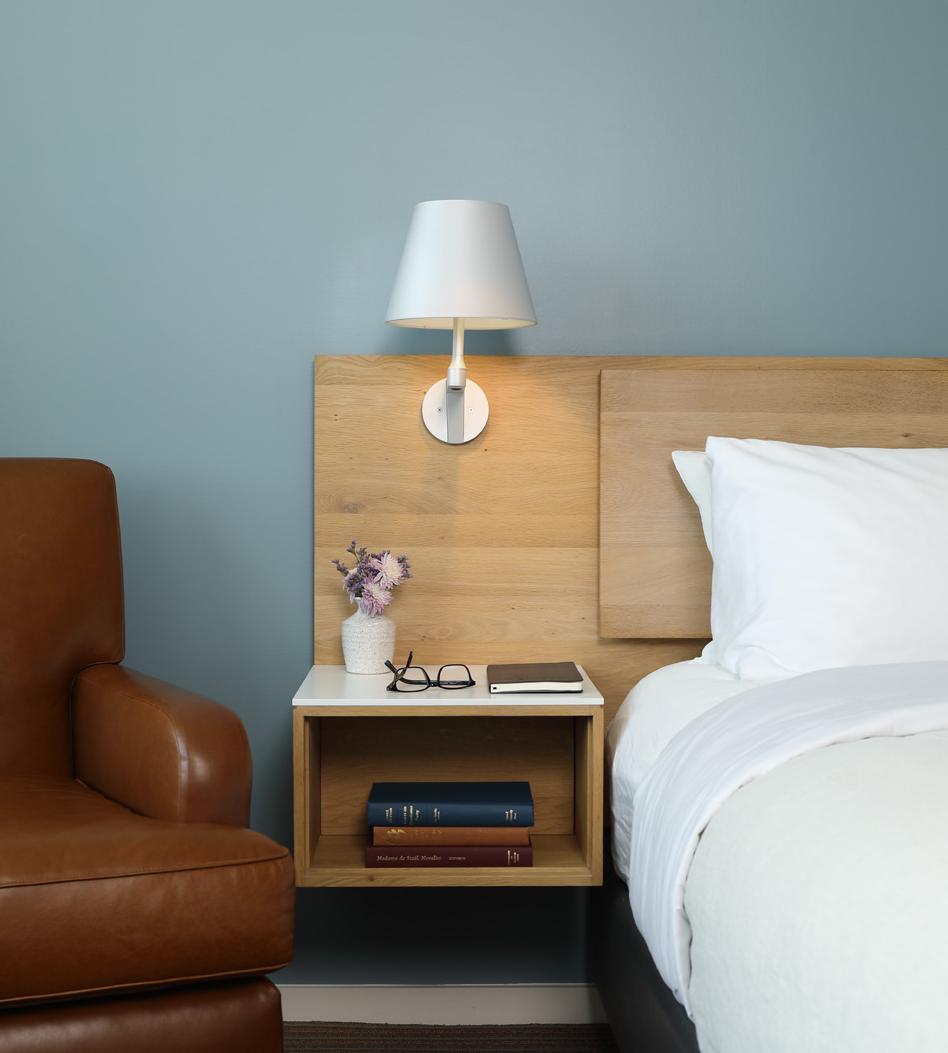











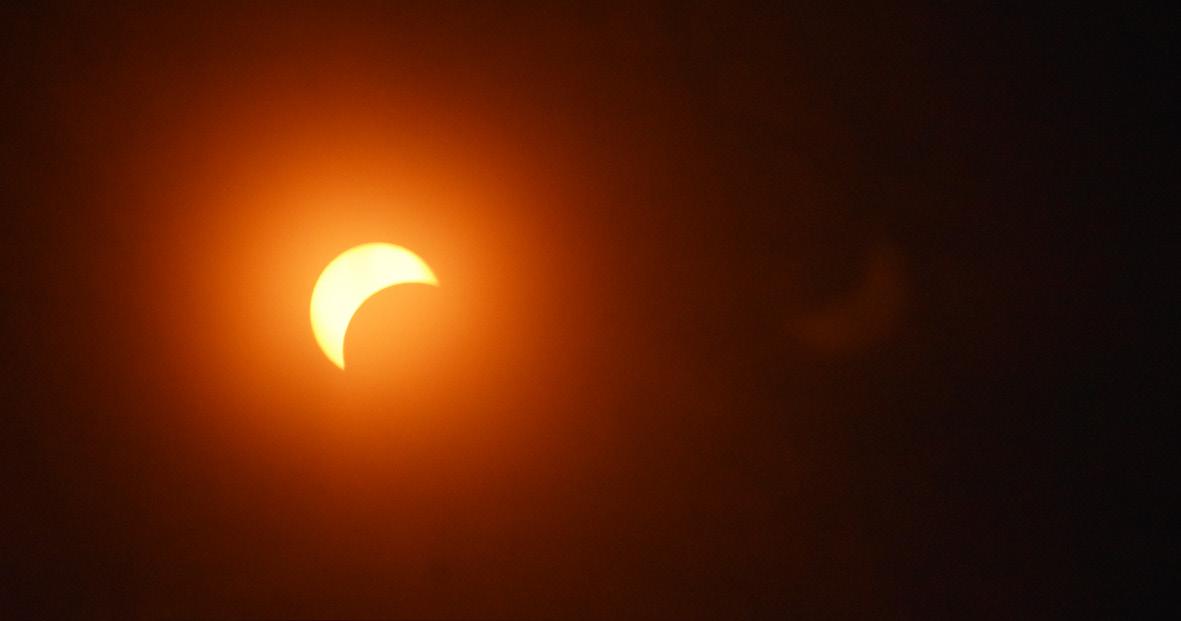

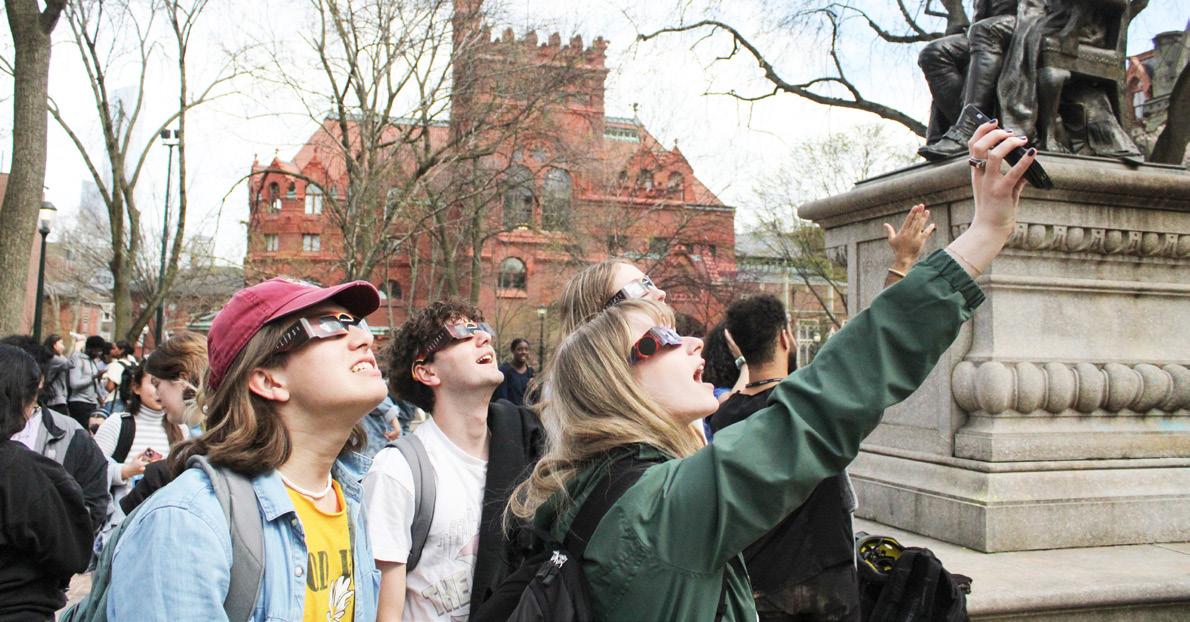

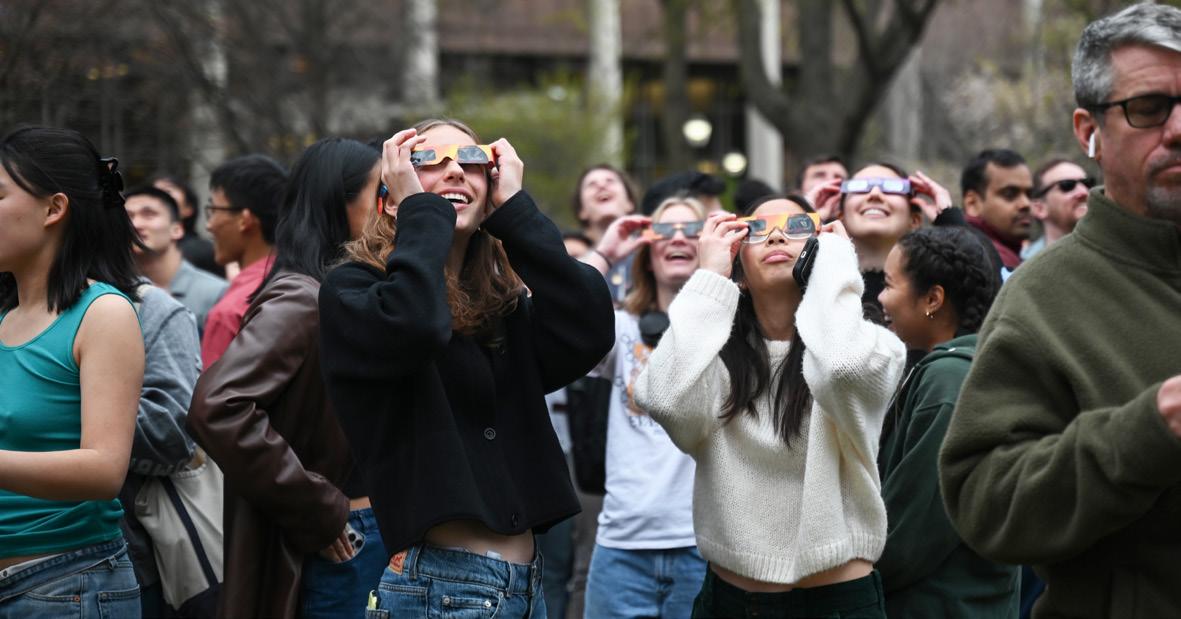
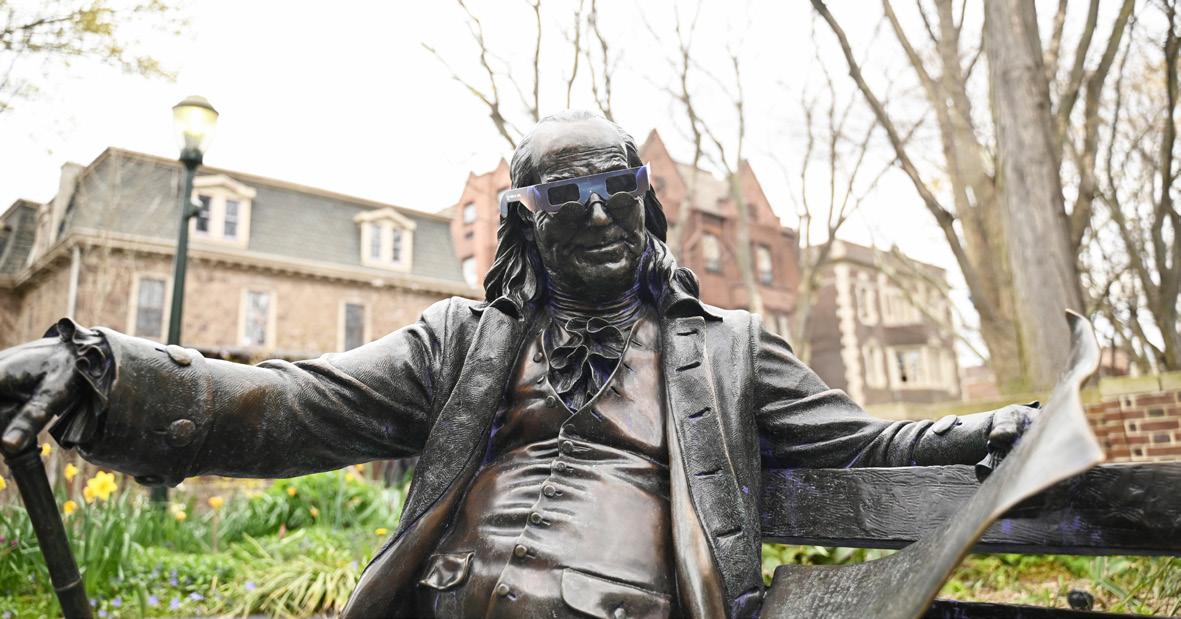
The PWH event preceded Francisco Sagasti’s speech at the TEDxPenn conference on April 6
JAKE KONIGSBERG Contributing ReporterFormer Peruvian President and 1972 Wharton graduate Francisco Sagasti spoke at the Perry World House on April 5 about the "art of governance."
This event was co-sponsored by PWH and TEDxPenn and moderated by Juan Gonzalez, a senior fellow at the Penn Biden Center and former National Security Council Director for Western Hemisphere Affairs. Throughout the event, Sagasti discussed how governance is prevalent in both our personal and political lives and how his Penn education played a vital role in his political career. Sagasti received his Ph.D. from Wharton in operations research and social systems sciences, which he said was helpful in “put[ting] together many different strands of thought into practice with respect to government.” He became the president of Peru in 2020, following the impeachment and resignation of his two predecessors within the span of a week. “It was not expected, but I was not unprepared, which allowed me to act in a sensible way,” Sagasti said. Sagasti inherited a nation suffering from the pandemic and socioeconomic turmoil. Within the span of five months, he secured 87 million doses of vaccinations, reactivated the economy, and instituted a successful general election and peaceful transition of power. Sagasti decided not to run for re-election to focus on the issues at hand.
Through this talk, Sagasti discussed how he achieved these results of his presidency through his
understanding of governance. Sagasti broke governance, the act of setting a course of action, down into three main areas: an initial approach, acts of appreciation, and outcome.
In terms of initial approach, Sagasti described the need to understand the context of the events occurring in terms of both the situation and the stakeholders involved. Acts of appreciation involve putting together one's values to determine in which direction to act, leading to a given outcome.
Sagasti attributed this analysis of governance to the social systems approach that he learned through his time at Penn. He then discussed how he applied these acts of governance through the major achievements of his presidency and how each act plays an essential role in taking action, an important aspect of everyone’s life.
“It was nice to hear from a leader who actually has experience and was able to integrate what he learned from Penn into his actual leadership experience,” College sophomore Louis Li said.
Sagasti finished his talk with the hope that the audience, along with others throughout the world, will “recognize the possibilities of Latin America and replace corrupt politicians with those who care about the common good.”
The PWH event preceded Sagasti's speech at TEDxPenn on April 6, where he joined nine other speakers from different backgrounds who discussed the theme "Limits to Infinity."


Sniegowski served as the chair of the Committee on Undergraduate Education and the Faculty Senate Committee on Students and Educational Policy.
“Paul has promoted inclusion in the undergraduate learning experience through a number of means,” Fluharty wrote in the announcement. “Being named to a college presidency is a tremendous honor, and Paul’s appointment at Earlham is a well-deserved tribute to his devotion to student learning and to liberal arts education.”
Earlham College, a Quaker college, is located in
Richmond, Ind. He will succeed Anne Houtman, who previously announced her planned retirement in July after a five-year term as president.
Sniegowski's son, Ben Kienitz Sniegowski, graduated from Earlham College in 2023, according to the Earlham announcement.
"We are coming to Earlham because we want to be a part of this community,” Sniegowski said in the Earlham announcement. “We want to help make this evermore a place where, once you’re here, you don’t want to leave.”
Earlham Board Chair Tom Thornburg wrote in the Earlham announcement that "Paul [Sniegowski] has been impressive and thoughtful in his excellent career as a faculty member specializing in evolutionary genetics and as dean of the College of Arts and Sciences at the University of Pennsylvania.”
“He is a strong researcher, a frequently honored teacher, and much appreciated academic leader,” Thornburg added.
Fluharty wrote in the announcement that the process to search for Sneigowski’s successor will begin “immediately,” and said that he will reach out to the Arts and Sciences community to "seek nominations of faculty and input on future priorities."
Fluharty added that SAS will be planning events to thank and congratulate Sniegowski before the end of the semester.


Penn af liates gathered by the thousands on College Green and beyond to celebrate the spectacle over shared viewing glasses, Moon Pies, and astronaut ice cream
NICHOLAS MAHARAJ Staff ReporterClouds may have congested the view of Monday’s solar eclipse from campus — but they did not dampen the spirits of the Penn community, which gathered by the thousands on College Green and beyond to celebrate the spectacle over shared viewing glasses, Moon Pies, and astronaut ice cream.
While Philadelphia was expected to experience 90% sun coverage, a surprise burst of clouds over University City covered the sun during the eclipse’s peak, which occurred at around 3:23 p.m. However, it was too late to turn away the crowds — the largest of which had gathered at a watch party held in front of Van Pelt-Dietrich Library organized by the University.
As the sky darkened slightly and maximum coverage approached, the crowd of students, faculty, and staff were joined by Penn administrators — including Interim Penn President Larry Jameson. Organizers of the watch party — jointly held by Wellness at Penn, University Life, Alumni Relations, and the Division of Recreation and Intercollegiate Athletics — distributed eclipse glasses, Moon Pies, Sun Chips, and astronaut ice cream.
The unforeseen cloudy weather during an otherwise sunny day was not the only hiccup. At the College Green watch party, Wellness at Penn ran out of eclipse glasses at approximately 3 p.m. after a line of community members waiting to receive a pair had grown to several hundred people. Groups of five were prioritized to receive glasses, causing smaller groups and individuals to be turned away.
A University Life spokesperson wrote to The Daily Pennsylvanian that organizers had over 500 pairs of eclipse glasses to distribute. The spokesperson added that organizers purchased all of the glasses that were available from a local supplier.
Since Wellness at Penn did not have enough glasses to accommodate the number of attendees, many students had to “make friends with others and share,” Director of Communications Mary Kate Coghlan wrote in a statement.
The collaborative effort was “so much fun to witness,” she said, adding that Wellness at Penn was “overwhelmed with how many students wanted to take part.”
A glasses distribution location at the Stuart Weitzman School of Design was also unable to meet the demand — contrary to the expectations of some students. Wharton senior Sarah Kim said that she did not buy glasses beforehand because she “had faith” that the University would have enough glasses for everyone.
“It’s nice to see so many people gathered for the event, [but] that’s why I wished the University did more,” Kim said. Wharton junior Mario Paez said he had looked forward to seeing the eclipse but was unable to after organizers ran out of glasses. Students were surprised by the number of their peers who had come to watch the event. Fifth-year cellular and molecular biology Ph.D. candidate Elana Pyfrom did not
anticipate that so many people would be excited about the eclipse, describing the line to pick up glasses as “horrific.”
Nonetheless, the large crowd on College Green — and the resulting fervor — had many community members distracted and quickly forgetting about the short supply of adequate glasses.
“The crowd is more interesting than the sun,” ophthalmology professor Joshua Dunaief said.
In the minutes before the peak of totality, Jameson told the DP that the watch party had “very good energy.”
“It’s a huge crowd, and it’s a beautiful day,” Jameson added, “[but] not too happy about the clouds.”
Shortly afterward, around 3:22 p.m., clouds were almost entirely covering the sun and the moon.
“It doesn’t look promising,” Jameson said. “It’s a shame.”
Students on College Green, including College first years Alecia Cameron and Hannah Kim, were disappointed that the sudden cloud coverage completely hindered their view of such a rare event.
Kim was still happy that students and faculty came together — adding that while they may have left disappointed, students had skipped class to see the eclipse.
The size of the crowd, combined with the suspense of the eclipse, evidently drew out some students and professors who were previously less inclined to watch the movement of the moon’s shadow. College first year AiLing Chen, for example, did not initially plan on coming to the watch party, but decided to stay after seeing the size of the crowd.
“I’ve never seen so many students gathered in one place at once,” she said.
While Paez had homework due, he said the solar eclipse allowed him to take a “little mental break.”
History professor Peter Holquist was holding office hours during the time of maximum coverage — but his students said there was “no way” he could miss the solar eclipse. “I’m taking my students’ advice,” Holquist said during the watch party. “It’s nice to [watch the solar eclipse] collectively and together.”
Administrators — including University Chaplain and Vice President for Social Equity and Community Reverend Chaz Howard and Executive Director of Student Affairs Katie Bonner — wrote in statements to the DP that they admired the cross section of students, faculty, and staff that had gathered to share in the spectacle.
Despite the glasses shortage on College Green and the cloud coverage, Penn community members generally said they enjoyed watching an astronomical rarity grace Penn’s campus. “It’s a once in a lifetime opportunity,” Kim said. “So I’m glad people got to experience it.”
News Editor Ben Binday, senior reporter Nitin Seshadri, and staff reporter Ethan Young contributed reporting.

people to run for student government,” Ellendula said. “And also help the student body feel the impact of the initiatives that we put forward and make sure that students know that there are people who are advocating for them.”
Chen also discussed her background during the campaign, coming from rural North Carolina, and spotlighted her leadership role in a project with Wellness at Penn to introduce a vending machine on campus to dispense overthe-counter medications.
College junior Amaan Omer, Wharton sophomore Vedika Jawa, and Wharton first year Steven Li — who is also a staffer for the DP — were respectively elected as the presidents of the 2025, 2026, and 2027 Class Boards. Omer won by a vote of 236 to 205 over Engineering junior Ben Sailors, and Jawa and Li were both unopposed.
All positions for the 2025 and 2026 Class Board were uncontested other than the election for College Class Chair for the 2026 Class Board. College sophomore Hita Mohan was elected with 139 votes to College sophomore Hannah Kim’s 121 votes.
The election’s voting period and results were both delayed by a day, which Elyoussef attributed to “a little glitch in the system.” He added that issues with the Penn Student Government website made no difference in the outcome of the election.
“I think the website itself does need a bit of work. It’s an older system, back when Penn InTouch was around,” Elyoussef said. “And so I think the NEC — along with
the rest of the University — needs to work to update the system. Just so we don’t have to run into these roadblocks.” Ellendula, in contrast, told the DP that the change in the voting period “probably” impacted the election cycle, but added that she was “not sure to what extent or to what degree.” “You always have to be prepared that sometimes things can go wrong with technology, or you’re faced with issues that are not really able to be controlled by any one person,” Ellendula said. “But I do want to say that I’m so appreciative to everybody in the nominations and elections committee, or NEC, for being communicative throughout the entire process and helping candidates who might have been confused with what the updated timelines were.”
Elyoussef also suggested that this election was unique due to the State of the School event, which was held on April 4. “We required all candidates to go to the State of the School, which was the event hosted by the NEC along with the rest of the Penn Student Government,” Elyoussef said. “Having candidates go to that meeting really shows them what all of student government is about, and really tells them what’s going on around campus and within student government.”
Last week, the NEC hosted two debates — one on April 3 and another on April 7 in the McNeil Building — where the UA presidential and vice presidential candidates explained their platforms and plans for the roles.

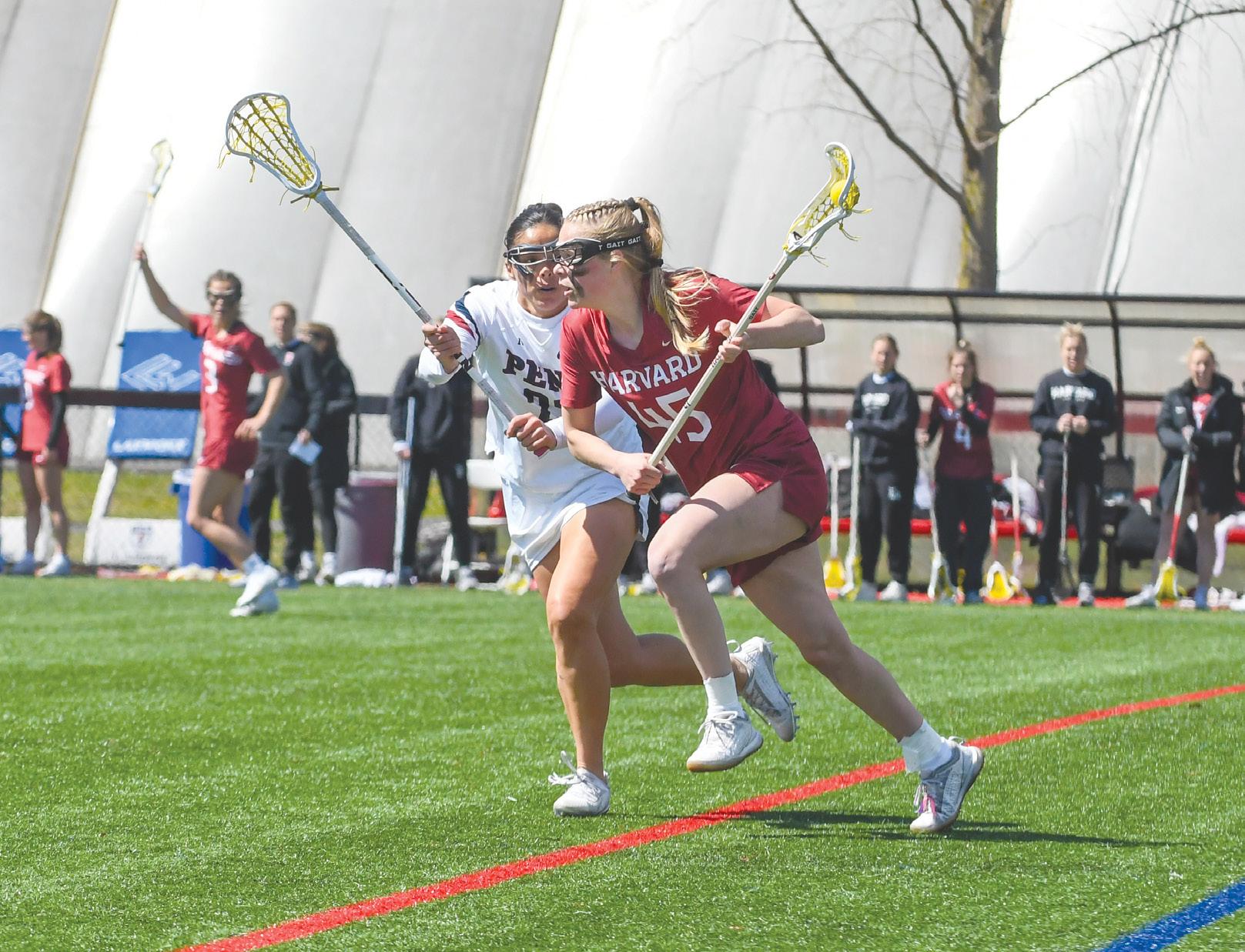
After starting the week tied for rst, the Quakers fall to fourth place in the standings with two consecutive losses in Ivy League play
As the defending Ivy League champions, No. 7 Penn women’s lacrosse’s journey to repeat as the queens of the Ancient Eight required a win New Haven, Conn. The Red and Blue’s loss to No. 18 Princeton on Wednesday left No. 16 Yale alone in first place as the only team left undefeated in conference play, heading into the game. The last time the two teams faced off was in the 2023 Ivy League tournament championship game, where Penn pulled away with a tight 15-14 overtime win. This time around, the Bulldogs got their revenge with a 16-8 win to preserve their undefeated run of the conference.
“I think Yale played really well,” coach Karin Corbett said. “The things that plagued us against Princeton plagued us today … We were sloppy with the ball in transition, as well as on attack, and then we just gave up too many looks on the defensive side, and we didn’t play with enough urgency on the attack.”
With Penn (8-3, 2-2 Ivy) and Yale (10-1, 4-0) both entering the matchup tied for third in scoring defense nationally, the stage was set for a low-scoring affair. This remained true for only the first quarter of play. As with the team’s previous game, the Quakers got off to a hot start. After Yale opened up the scoring with attacker Jenna Collignon’s first of the contest, freshman attacker Catherine Berkerey and junior attacker Keeley Block scored in quick succession to give Penn an early 2-1 lead.
However, the lead for the Quakers did not last long, as Yale closed the quarter with a 3-0 run to give the Bulldogs a 4-2 advantage. Their scoring run continued into a second quarter, where the Bulldogs found the back of the net six times in comparison to the Quakers’ one. The seven-goal deficit the Red and Blue entered the halftime break with was the largest deficit that the team has faced this year.
Coming out of the break, even with the switch from a zone to man defense, many of Penn’s struggles continued. Across the day, the Quakers had trouble possessing the ball and converting those possessions into goals. After tallying 41 shots against Princeton earlier this week, Penn finished the contest recording just 19 shots against a suffocating Bulldog defense, and their first goal of the second half didn’t come until junior midfielder Gracie Smith scored off a free position with just three minutes left in the third quarter.
It took the Quakers midway through the fourth quarter before the team finally seemed to settle into some form of rhythm on offense. Junior midfielder Anna Brandt finally found herself on the scoresheet, finishing the game with two goals — both from the fourth quarter — while
Berkerey added on to her own tally to close out the game with a team-leading three goals. But it was too little, too late as the Red and Blue suffered its largest loss since a 15-7 defeat to Loyola Maryland over a year ago.
“The third quarter was tough in that we didn’t get the ball a whole lot, so it was hard to make some of those adjustments,” Corbett said. “But then I think in the fourth quarter, we did once we started to get the ball a little bit towards the end, but it’s a little bit too late.”
The 16 goals scored by Yale were the most the Penn defense has conceded this season, and this was the second consecutive game that the unit has let in double digit goals. A large reason for this was the amount of time that defense was forced to play, as Penn’s offense couldn’t get into rhythm. Despite the defense producing turnovers and getting stops, many of the possessions ended in turnovers or saved shots, giving the defensive unit very little time to rest.
“We also struggled on the draws,” Corbett said. “We just couldn’t get the ball on the draw. So the drawers were only a three difference, but it was kind of when they happened. We just couldn’t get the ball much in the third quarter, and that’s when they went on a big run.”
After starting the week tied for first place in the Ivy League with Yale, two consecutive losses to No. 18 Princeton and Yale sank the team in the rankings to fourth place — now tied with Brown and Cornell. An Ivy League tournament appearance that once seemed like a forgone conclusion for the Penn squad is now being called into question, as one more loss in league play would mean that the preseason favorites to win the conference will see their season ending prematurely.
The loss all but mathematically eliminates the Quakers from repeating as Ivy League champions as well. With Yale now at 4-0 in the division and Princeton and Harvard close behind with 3-1 records in division play, even if Penn wins the rest of its games, it will take a lot of favorable results across the last three weeks of conference play in order for the team to come out on top.
Penn women’s lacrosse will continue its streak of road games, heading to Ithaca, N.Y. to face off against Cornell on April 13 at 12 p.m. In a must-win match for the Red and Blue, the team will be looking to get back into the win column in Ivy League play.
“We have a whole week to prepare,” Corbett said. “We have a good four days to work on some of the things that we need to do better for ourselves and then look towards Cornell towards the end of the week.”
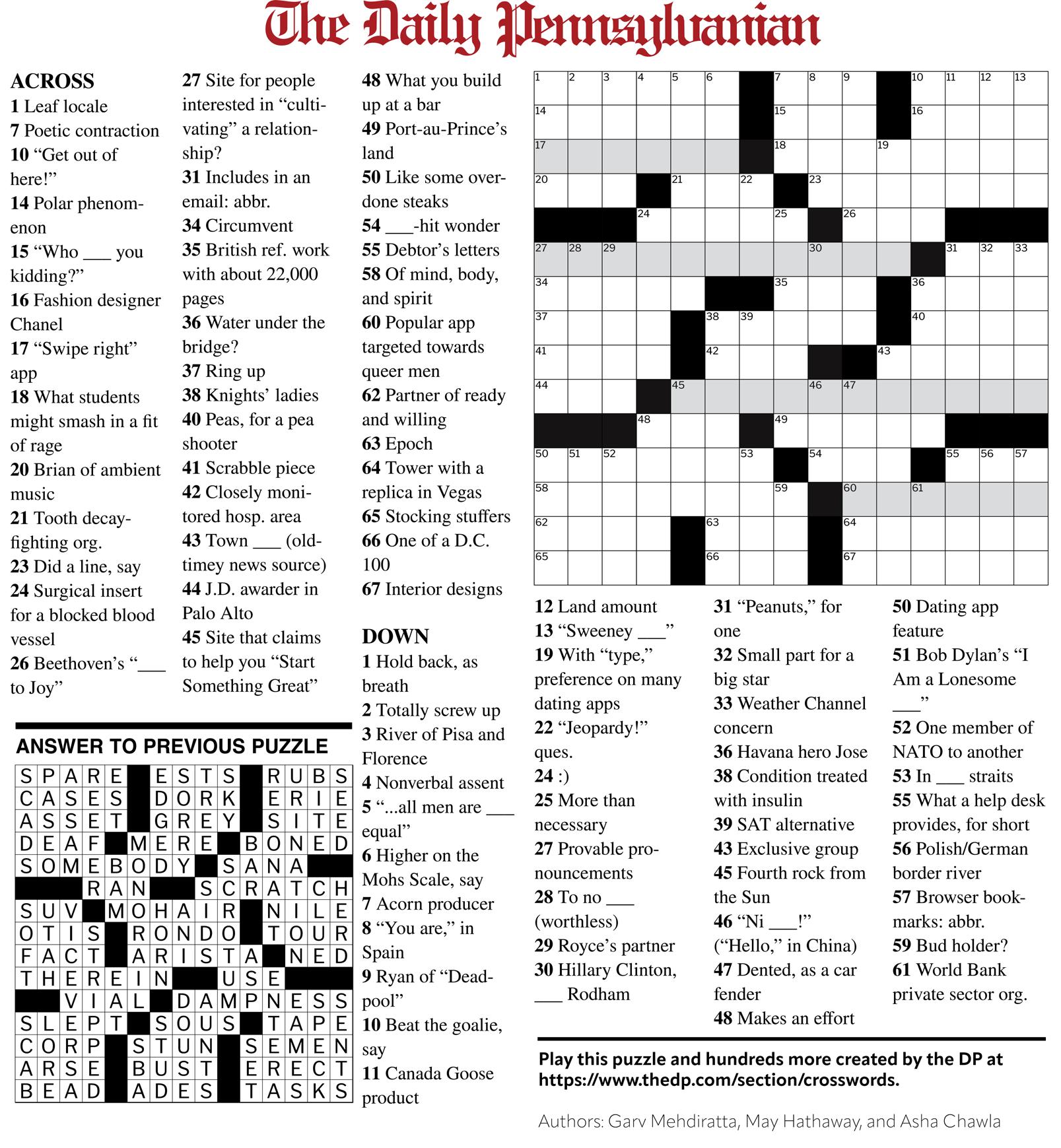
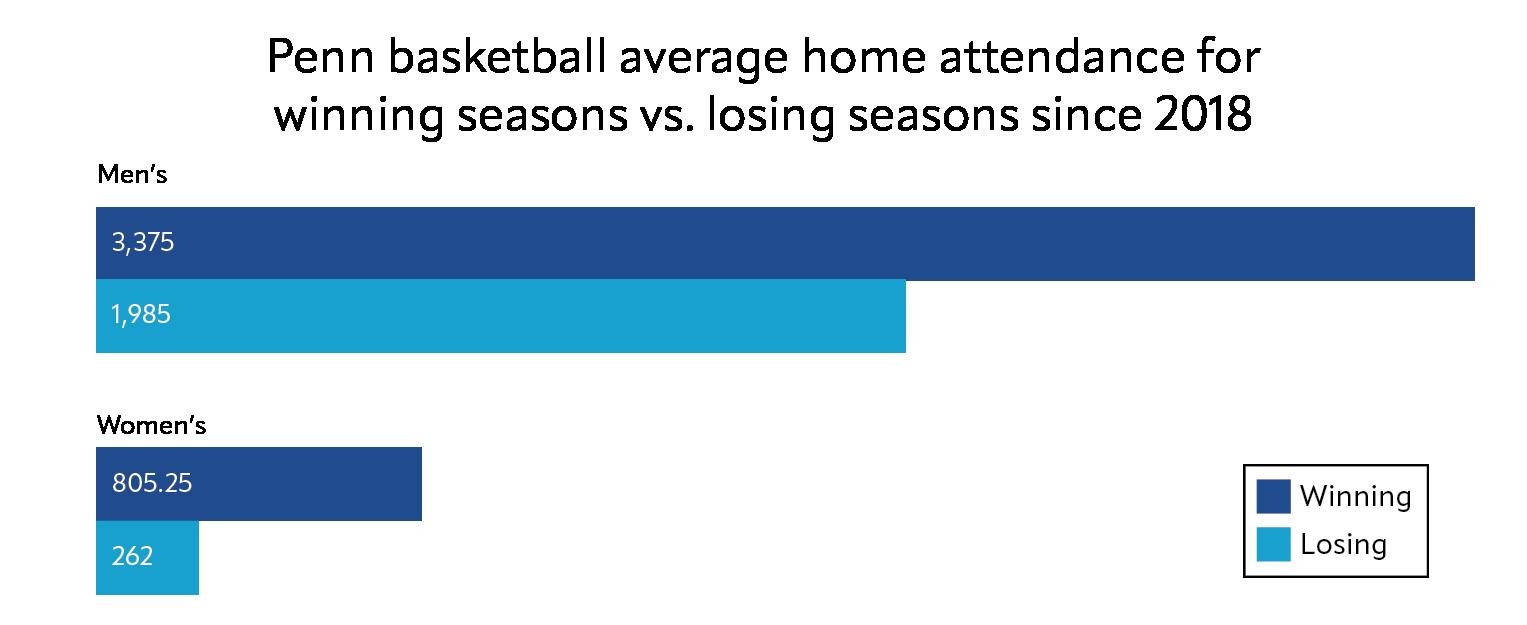
BASKETBALL , from BACK PAGE
losing seasons, while the women’s team saw 805 attendees per game during winning seasons and 262 during losing seasons.
At Penn, both men’s and women’s attendance has declined since 2018, although the discrepancy between the two has also shrunken. However, across the entire Ivy League, a different trend has emerged: While men’s attendance has declined slightly since 2018, women’s attendance has grown.
In 2023-24, Ancient Eight men’s basketball drew a home average of 1,549 attendees, down from 1,760 in 2018-19. On the women’s side, 2023-24 saw an average of 788 attendees, up from 701 in 2018-19.
“Penn Athletics does a great job of trying to get students to come to our games, like elementary school students and different local schools,” Stanfield said. “… And I think like other student-athletes, they’ve tried to bring them to our games. So I feel like all of those initiatives really help. … There’s just been a lot of growth since I’ve been playing, which is nice.”
While the basketball community has made strides toward a more equal playing field for men’s and women’s teams, the attendance discrepancy at Penn and throughout the Ivy League is a reminder that the game still has ground to cover. For teams, players, and coaches across the Ancient Eight, the ultimate hope is that in the seasons to come, the gap will continue to shrink.
All statistics are courtesy of the Ivy League. Attendance averages are calculated using the average home attendance per season per team.
At Penn, Stanfield believes the athletic department does well in its promotion of the women’s team, and says that the overall flourishing of women’s basketball on the national level has been a welcome sight.
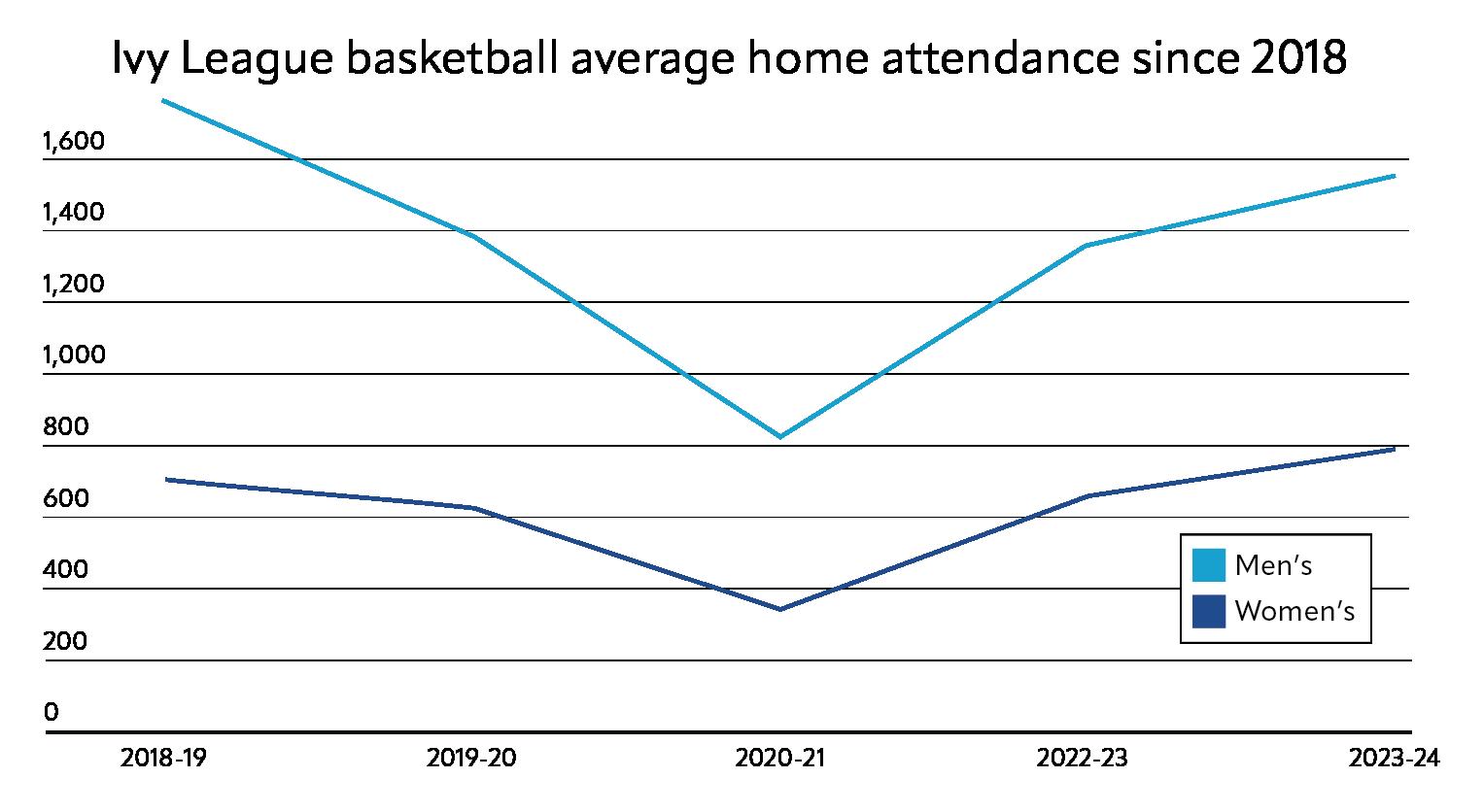

WEINING
Slajchert is the second notable Penn basketball player to join the Trojans in as many seasons. Last year, Penn women’s basketball guard Kayla Padilla, who also hails from California, transferred to USC for her final year. Padilla was the fourth-leading scorer on a Trojan team that earned a No. 1 seed in this season’s NCAA Tournament. Slajchert overcame a significant amount of adversity during his Penn career. During the COVID-19 cancelation, he suffered a swelled contusion in his quad that cut his preparation time for the following year. Then, during his senior season, Slajchert missed over a month with an ankle injury. He was nonetheless an incredibly impactful player during his time with the Red and Blue, and now gets a chance to make an impact for the Cardinal and Gold.
“In terms of competition level, I think the Big 10 is a step up,” Slajchert told The Daily Pennsylvanian. “The Ivy League is a different challenge in a lot of ways … I’ve
10.
got to be ready to be more physical, get stronger, and be ready to play against bigger guys with more athleticism.” This season, USC men’s basketball went just 15-18 while finishing ninth in the now-defunct PAC-12. Despite a roster featuring a number of notable players, including Bronny James, problems persisted for the Trojans. They hope Slajchert will be a part of the solution next season. “What I can bring is what I learned here, being in the Ivy League the last four years,” Slajchert said. “Being coached by coach Donahue has prepared me really well to go and play against stiff competition … it’s an opportunity for me to prove I belong.”
With Slajchert gone and freshman guard Tyler Perkins also in the transfer portal, Penn will likely be forced to replace its top two scorers from this campaign. After winning just three Ivy League games, the Quakers will look to improve in the campaign to come, but they will do so without several of last season’s key contributors.
“These were the most formative years of my life, these last few years here have made me who I am,” Slajchert said. “I just hope I didn’t take that for granted … I knew I was so blessed the whole time I was here, and the only thing I regret is not winning an Ivy championship.” Sports Deputy Editor Sean McKeown contributed reporting to this story.

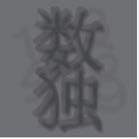






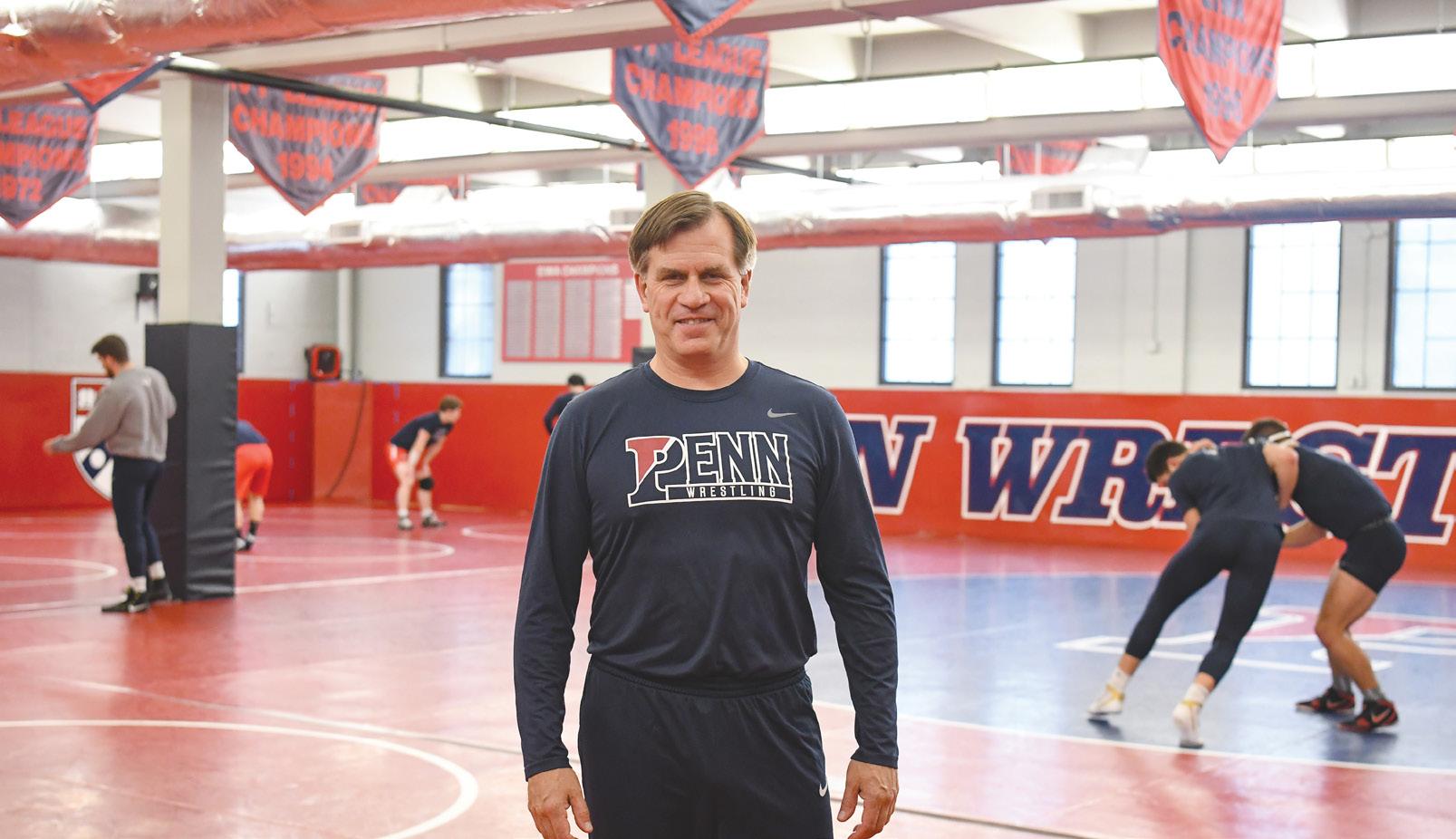
Penn wrestling coach Roger Reina will step down from his role after the 2024-25 season.
begin working with Matt along with our staff in the continued pursuit of our goals.”

changeover from one coach to another and put the program in the best place to succeed moving forward.
“This thoughtful transition will enable our Penn wrestlers, families, staff, and alumni to work together over the next two years to effectively navigate the change and empower the successful future of Penn wrestling. Our community is committed to a lasting legacy of excellence,” Reina said. “I am excited to
Valenti began his coaching career as an assistant at Columbia from 2007-2009 before serving as an assistant coach at Penn from 2009-2015. He will now return as associate head coach, and look to positively impact the program before taking the reins in 2025.
“I’m excited for the opportunity to work with coach Valenti,” Penn wrestling Director of Operations Kevin McGuigan said. “Our staff is getting stronger and the future of Penn wrestling is in good hands with a solid path forward and upward.”
Sports Associate Conor Smith contributed reporting to this story.
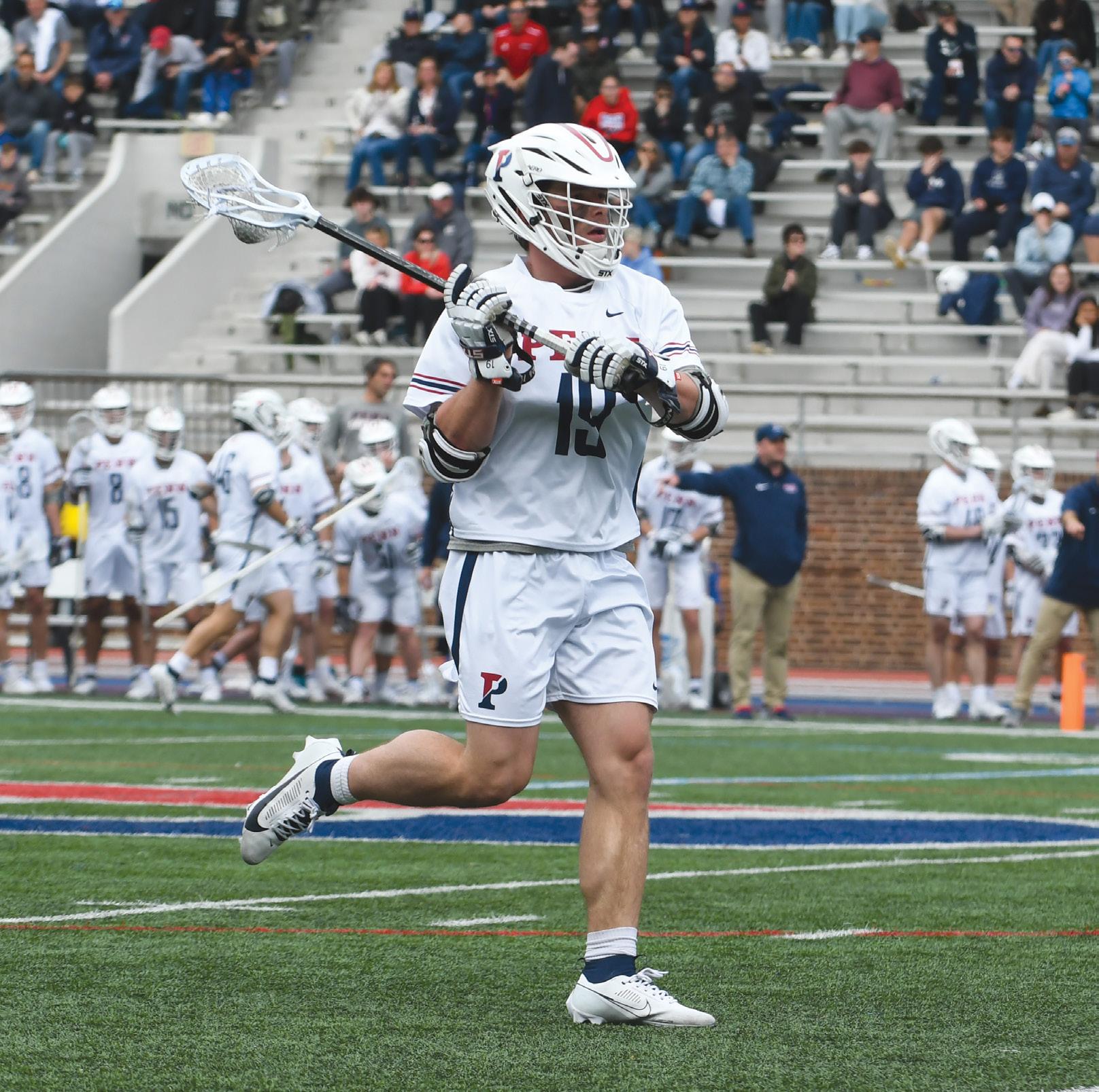
nickname] just stuck because I said it before, but I’m not the tallest first baseman,” Lesko said. “But I hit the splits one time. And all of a sudden, my nickname is ‘Stretch’”.
Lesko’s nickname followed her all the way to college, kept alive by her unorthodox style of play, and many new teammates would at first only get to know her as such.
“When we were younger, some people would not even know my real name,” Lesko said. “Because everyone was calling me ‘Stretch,’ these people would genuinely think that I’m ‘Stretch Lesko.’”
For Lesko, being called “Stretch” is the ultimate sign of respect. To herself, it shows that other people have taken notice of her unique athletic feats on the field — feats that she notes are not “super typical of an athlete.” Lesko has already made big waves on campus — she is the only freshman on this list — and it is not a “stretch” to predict that her impact will continue to grow in her years to come at Penn.
Sam “The Beacon” Sullivan
Standing at 6-foot-5, junior First Team All-American heavyweight rower Sam Sullivan towers over his competition — but his height is not his most defining physical quality. Sullivan rocks a beautiful, flowing blond afro that he proudly shows off at every regatta. The combination of his height and hair landed Sullivan the very appropriate nickname of “The Beacon,” as he is impossible to miss.
“You see me, especially, on the water while we are racing,” Sam joked. “We kind of all look the same, but if you see my boat, you can tell it’s my boat.” For the heavyweight rowing team, nicknames are a way to joke around while also establishing a way for people to make personal connections within their team culture. While Sullivan and his teammates relish in the opportunity to create monikers for one another, he has also heard other less flattering terms thrown around for himself by non-Penn rowers, such as “Albert Einstein.” Sullivan personally enjoys rival nicknames, as they are all in good fun, but clarifies that none will ever live up to “The Beacon.”
affectionate shortening of his last name that has tagged alongside Ryan’s athletic career from high school to college — much to his surprise.
“Yeah, I got on Penn’s campus thinking that there’s no way I’m gonna get called ‘Drombo’ here. I’m just ‘Ryan’ now,” Dromboski said. The nickname itself may not seem too out of the ordinary, but it’s the way that people say it, with much gusto and a drawn out “o” that drives home the type of presence Dromboski brings to the table.
Dromboski’s predication could not have been more incorrect, as his new teammates quickly clung to “Drombo” and have yet to let go. He remains open to the possibility of wearing his nickname on the back of a jersey, should the right cards fall into place.
“I know that the Savannah Bananas have gotten a lot of attention. And if I were to play for them, I would definitely have ‘Drumbo’ on the back,” Dromboski said.
On top of “Drombo,” Ryan was also given the nickname “Dropbombski” as a freshman in high school, when he was known for his hitting as well as his pitching.
“The seniors called me ‘Dropbombski,’” Dromboski explained. “I used to swing the stick, which was awesome.”
Many professional athletes are also given nicknames by the media due to their salient emotions on the field, furthering the connection between athletes and fans. In a profile written by The Daily Pennsylvanian, Ryan was gifted his most recent epithet, “The Lion Man” — a name he embraces fully.
“I play with a lot of emotion on the mound, and I’m always, I guess, ‘roaring,’” Dromboski admitted. “Letting it all hang out. You know, heart on my sleeve.”
Julien “Juice” Stokes
Penn football senior wide receiver and all-Ivy return specialist Julien Stokes rarely answers to his government name.
“A lot of my coaches don’t even know my first name,” he said. “Some of my teachers here, they call me ‘Juice.’” The nickname has been so integral to his life that Stokes had to phone his father to verify the full story of its origins.
“Juice” is derived from Stokes’s first nickname, “Juju.” The “Ju” sound was later morphed by his father into “Juice” due to his play style being “as cool as ice.”
“Every time I got the ball, I would hit the edge and just dart out. I was like electric, dynamic, and there was a certain type of energy when I had the ball in my hands,” Stokes said. “One day, my dad just called me ‘Juice,’ and from there, it just stuck.”
“Juice” has also taken on a life of its own off the field. Everything from Stokes’ social media handles to his custom-made “Got Juice?” hoodies showcase the nickname. Being addressed as anything else is rare. “When I hear ‘Julien,’ it kind of catches me off guard,”
a game-high three goals, officially making him tied with Ben Reeves as an all-time top scorer in Yale program history.
double overtime
against then-No. 7
Penn (7-4, 3-1 Ivy) proved that it
that
Against
a battle-
even when down
with
(7-2, 3-1), the Quakers once again found themselves relying on this grit as the team went down by multiple goals on three separate occasions. The Bulldogs came out of the gates hot, scoring the first two goals of the game. The Red and Blue were unable to capitalize on a man-up opportunity during this same frame of play, with the team’s first goal of the game not coming until nearly seven minutes into the game off the stick of sophomore midfielder Griffin Scane. Scane’s goal seemed to be the spark needed to get the Penn offense going. Four minutes later, senior midfielder James Shipley scored his first goal of the game to tie things up at two apiece. However, the team’s failure to consistently win the faceoff cost the Quakers as Yale was able to score on back-to-back possessions to give the Bulldogs another two-goal lead.
Penn controlled the first half of the second quarter, going on a 3-0 run that saw junior attacker Ben Smith score two goals to give the Quakers their first lead of the game. That lead lasted just one minute and three seconds before Yale went on a four-goal run to give the Bulldogs a comfortable three-goal lead heading into the halftime break.
A huge reason for the Bulldogs’ success on offense can be attributed to senior attacker Matt Brandau. Brandau currently leads the nation in points per game and entered the matchup three goals shy of tying the Yale program all-time scoring record. Brandau’s first goal of the game didn’t come until midway through the second period, but after that, he caught fire. Brandau finished the game with
Yale’s biggest lead of the game came early in the fourth quarter after attacker David Anderson’s second goal of the game gave the Bulldogs a five-point lead. With the team’s situation looking dire, senior goalkeeper Emmet Carroll did his best to keep the Quakers alive. After having a mediocre first three periods by the reigning Ivy League Defensive Player of the Year’s standard, Carroll came alive in the fourth quarter, finishing the game with 16 saves — one shy of his career game high.
Unfortunately, Carroll’s stand in the cage was all for nought as the Quakers uncharacteristically struggled in clearing the ball on the day, completing just 13 out of 19 of the team’s clears. After a goal from junior defender Tyler Kuehl — his first career goal — cut the lead to just three with over six minutes left in the fourth quarter, the Yale defense stiffened. The Quakers were unable to see the ball into the back of the net for the remainder of the game, capping off a disappointing performance for the Red and Blue.
Ultimately, Penn’s failure to consistently take advantage of its possessions by conceding unforced turnovers and failing to cleanly clear the ball spelled disaster for the team against Yale’s high octane offense. Junior attacker Tynan Walsh and Penn’s current point leader on the season was held to just one assist as the team struggled to break through the Bulldog defense.
With no more undefeated teams left in the Ivy League, the path to the postseason became slightly more complicated for the Quakers. With the target number of wins to ensure a postseason appearance set at four, Penn will now have to pick up a win in one of its last two games. And to ensure a share of the regular season crown, the Red and Blue will have to close out the regular season with two straight wins — no easy feat, considering five out of eight teams in the conference are currently ranked nationally.
Penn men’s lacrosse will be looking to secure that fourth win as the team travels back to Philadelphia for its penultimate home game to take on Harvard on April 13 at 1 p.m. on Franklin Field.
Ryan “Drombo / Dropbombski / Lion Man” Dromboski Penn baseball’s resident stud and junior pitcher Ryan Dromboski flaunts a personality that is larger than life, and it is only fitting that his nicknames should follow suit. He is principally known as “Drombo,” an













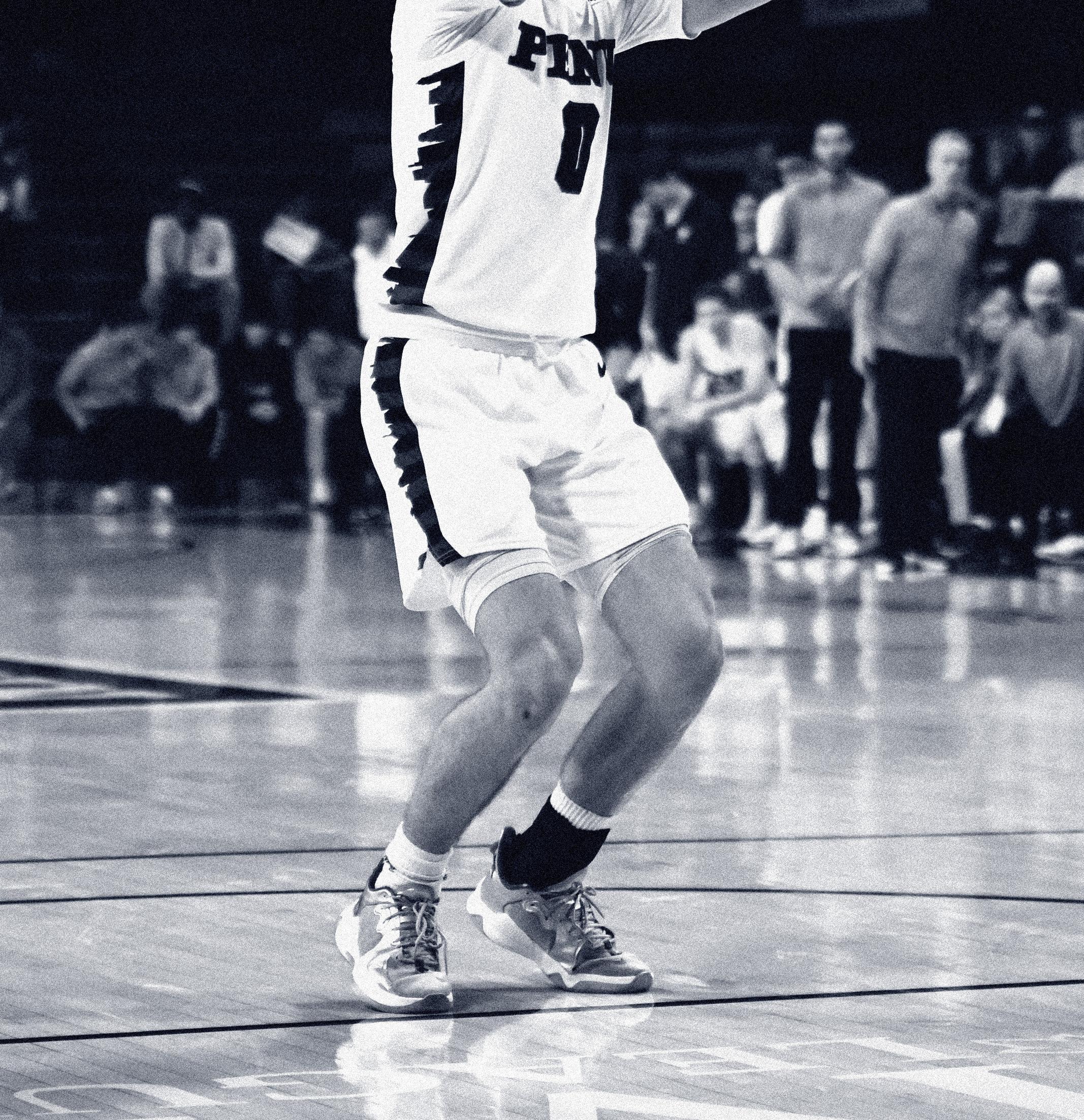

Penn has the largest discrepancy in home attendance between men’s and women’s basketball in the Ivy League, an analysis of attendance data by The Daily Pennsylvanian found.
The analysis examined home basketball attendance for all eight Ivy League schools over the last five seasons, a period which does not include 2020-21, when all winter sports were canceled due to the COVID-19 pandemic.
During this span, Penn displayed the greatest difference in attendance between men’s and women’s basketball of any Ancient Eight school, with Penn men’s basketball drawing an average of 2,819 attendees per game and Penn women’s basketball garnering an average of 697 attendees per game.
Penn also had the highest combined basketball attendance during the same period. Historically, women’s basketball generates lower attendance than men’s basketball across all levels. However, proponents of the women’s game argue that this disparity is not justified.
“I think Penn [women’s basketball] also has a lot of exciting players,” Penn women’s basketball senior guard Michaela Stanfield said. “Like [freshman guard] Mataya [Gayle] had a really great year. It’s definitely entertaining to watch. … In terms of the regular student body, we could definitely try to get more of them to come.”
The school with the smallest difference between
men’s and women’s attendance was Columbia, which drew 1,554 average attendees for men’s games and 998 average attendees for women’s games over the five-year stretch. During three of those seasons — 2021-22, 202223, and 2023-24 — the Lions’ women’s team was better
Reina’s successor, Matt Valenti, is the Quakers’ all-time wins leader and won two NCAA Championships during his collegiate career
Penn wrestling coach Roger Reina, the winningest coach in the program’s history, will step down from his position at the conclusion of the 2024-25 season, Penn Athletics announced Thursday. Reina will be succeeded by another all-time great Quaker: Matt Valenti, who wrestled for the Red and Blue from 2004-2007. Valenti is the program’s alltime wins leader with 137 wins, and won two NCAA national championships in 2006 and 2007.
“As a proud alumnus, it is a tremendous honor to step into a leadership role with the Penn wrestling program,” Valenti said in a press release from Penn Athletics. “... Together with the Penn wrestling team, alumni, staff, and community, I look forward to
forging a path of continued success both on and off the mat.”
Over Reina’s two stints as head coach, the first from 1985 to 2005 and the second from 2017-present, he has amassed 248 total wins and led the Quakers to eight Ivy League titles. This season, Penn finished No. 25 in the NWCA Coaches poll and qualified eight wrestlers for the NCAA Championships.
Although Reina will resign as coach at the end of next season, he will remain involved with the program and serve as coach emeritus during the 2025-26 season. The team believes this decision will ease the






attended than the men’s team. This season, collegiate women’s basketball as a whole has experienced a meteoric rise in popularity, both in regards to in-person attendance and television viewership. Earlier this season, the Big Ten women’s basketball
postseason tournament sold out for the first time in history, thanks in part to the massive popularity of Iowa guard Caitlin Clark.
On Sunday, the women’s national championship game between Iowa and South Carolina garnered 18.7 million average viewers, making it the most viewed women’s basketball game of all time and the most viewed English language sporting event in America, excluding football and the Olympics, since 2019.
“A really great example we’ve seen this year was Caitlin Clark and the finals,” Stanfield said. “I think that just proved that women’s basketball is really exciting and can draw a lot of viewers, which I think is some of the criticism sometimes.”
During the allotted time period, Penn men’s basketball ranks first in the Ivy League in attendance, while Penn women’s basketball ranks fourth. In terms of oncourt success, men’s basketball has a record of 75-70 during these seasons, while women’s basketball has a record of 88-53.
Overall, both teams demonstrated an increase in attendance during winning seasons (seasons with more wins than losses). The men’s team garnered 3,375 attendees per game during winning seasons and 1,985 during
Penn men’s basketball senior guard Clark Slajchert will transfer to the University of Southern California for his final year of collegiate eligibility, he told On3Sports. Slajchert, a Los Angeles native, returns home after an illustrious career with the Quakers. During his senior season, Slajchert led Penn in points per game, was named Second Team All-Ivy, and became the 43rd player in program history to score 1,000 points. “[Slajchert] gets to experience the highest level, and I think he’s really ready for it at this point in his career,” coach Steve Donahue said. “I know he’s excited to go home, and I’d love for him to have an incredible
experience and go to the NCAA tournament, but it’s just bittersweet a little bit.”
The departure is the result of a conflict between NCAA and Ivy League policy. In 2020, Slajchert’s freshman season was canceled due to the COVID-19 pandemic, and the NCAA granted all such athletes an additional year of collegiate eligibility. However, Slajchert is unable to use that year at Penn because the Ivy League prohibits graduate students from participating in athletics.
See SLAJCHERT, page 10 See